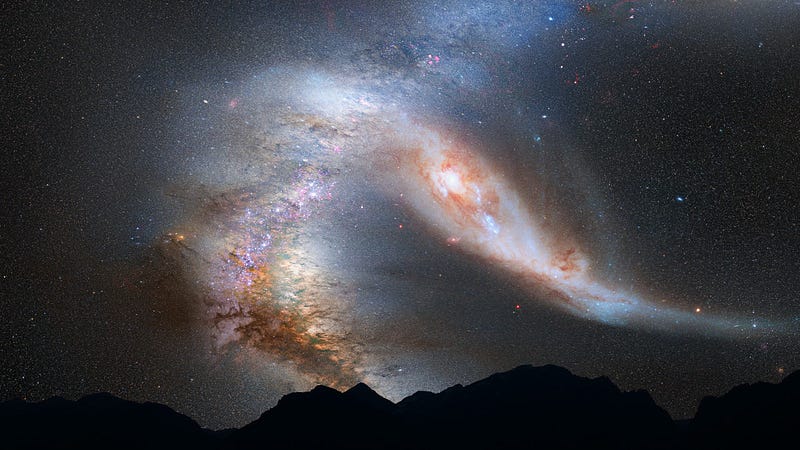Rethinking the Formation of the Milky Way Galaxy: New Insights
Written on
Chapter 1: The Milky Way's Mysterious Past
Recent research indicates that the Milky Way galaxy may have undergone a significant merger with a smaller galaxy approximately 10 billion years ago.

This galactic event likely transformed the structure of the Milky Way. In about four billion years, our galaxy is expected to collide with Andromeda, creating a spectacular view in the night sky, as depicted in this artistic rendering.
A study of around 100 red giant stars surrounding the Milky Way has shed light on this merger, employing advanced techniques to assess their ages. The findings offer insights into not only the Milky Way's formation but also the evolutionary processes of galaxies throughout the universe.
According to the researchers in Nature Astronomy, “The Milky Way, akin to other disk galaxies, experienced tumultuous mergers and the accretion of smaller satellite galaxies during its formative years. Thanks to the Gaia Data Release 2 and recent spectroscopic surveys, we can now identify the stellar remnants from these mergers.”
Section 1.1: Cosmic Symphony of Stars
Sound waves that traverse stars, analyzed through asteroseismology, reveal the intricate processes occurring within their cores. The chemical makeup of these stars has also been scrutinized through the APOGEE survey, providing additional evidence regarding their ages.
Some stars currently found in the Milky Way are believed to have originated from a satellite galaxy known as Gaia-Enceladus, while others were part of the early star population of our galaxy. Fiorenzo Vincenzo from Ohio State University’s Center for Cosmology and Astroparticle Physics noted, “Our research indicates that when the merger took place, the Milky Way had already established a significant number of its own stars.”
The data revealed a pattern: the "homegrown" stars, which existed prior to the merger, tend to cluster near the center of our galaxy, while those from Gaia-Enceladus are predominantly located nearer the galaxy's edges. Notably, the stars from the satellite galaxy are younger than those developed in the Milky Way itself.
Subsection 1.1.1: The Beauty of Galactic Mergers

The study of our galaxy is paradoxically challenging because we are situated within it.
Researchers at the Vera C. Rubin Observatory explain, “Observing a galaxy from within poses unique difficulties. Even a thorough census of stars in the Milky Way has eluded us, largely because a significant portion consists of faint, small red dwarf stars obscured by extensive dust clouds. Developing a three-dimensional map of the Milky Way has also been a challenge, leaving many details about its structures and stellar associations out of reach.”
The merger event significantly disrupted the galaxy, affecting the orbits of native stars and rendering their trajectories more chaotic. Additionally, the stars that emerged from this merger exhibit different chemical compositions compared to those that existed in the Milky Way prior to the event.
Josefina Montalban from the School of Physics and Astronomy at the University of Birmingham remarked, “The merging event with Gaia-Enceladus is believed to be one of the most consequential in the history of the Milky Way, fundamentally influencing our current observations of it.”
Expanding this investigation to include a broader sample of stars will enhance our understanding of the Milky Way's formation and the development of our star system long before Earth came into existence.
The upcoming launch of the James Webb Space Telescope this Autumn promises to deepen our knowledge of galaxy formation by probing the depths of space and examining the earliest galaxies in the universe.
James Maynard, the founder and publisher of The Cosmic Companion, is a New England native now residing in Tucson with his wife, Nicole, and their cat, Max.
Did you enjoy this article? Join us on The Cosmic Companion Network for our podcast, weekly video series, informative newsletter, news briefings on Amazon Alexa, and more!
Chapter 2: Visualizing the Galaxy's Evolution
The first video, titled "Simulation of the Formation of the Milky Way Galaxy," illustrates the processes and events that shaped our galaxy over billions of years.
The second video, "The Evolution of the Modern Milky Way Galaxy," explores how the Milky Way has developed into the structure we observe today.